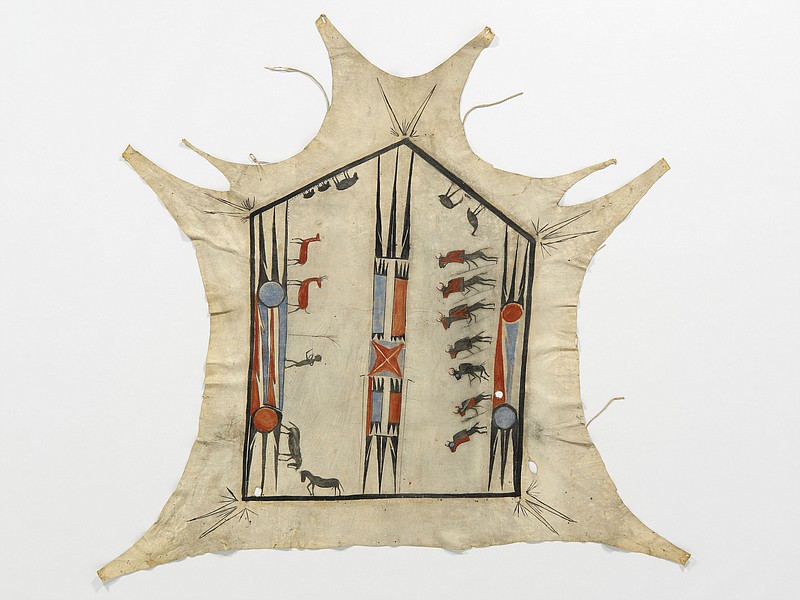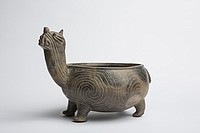- A leaky roof, a coonskin cap, a fiddle and a jug were not the outstanding characteristics of early Arkansas.
- — Louise Watkins Wright Loughborough, founder of Historic Arkansas Museum
Reading the new volumes of the Second Edition of "Arkansas Made" is like rummaging through the attic of our scrappy little state.
Totaling more than 1,300 pages, the two books, published in February by the University of Arkansas Press ($39.95 each), collect an impressive trove of the state's treasures — the work of thousands of artisans and artists who created here in the Natural State.
Volume I features quilts, textiles, ceramics, silver, weaponry, furniture, vernacular architecture and Native American art; Volume II focuses on photography and fine art. Both are subtitled "A Survey of the Decorative, Mechanical, and Fine Arts Produced in Arkansas Through 1950."
These new books — hefty, hardback and beautifully laid out — appear 21 years after the publication of the first pair of volumes of "Arkansas Made."
Like the new books, the first were written by Swannee Bennett and William B. Worthen of the Arkansas Territorial Restoration, now known as Historic Arkansas Museum. Jennifer Carman, owner of Little Rock-based art advisory and appraisal firm J. Carman Inc., wrote Volume II of the Second Edition with Bennett and Worthen.
The items come from Historic Arkansas Museum's vast collection, private collections, museums across the country and from as far away as France.
There's a Clovis spear point from 12,000-10,000 B.C., photographs by Mike Disfarmer and Dorothea Lange, beautiful and rustic quilts, a print by artist John James Audubon, portraits by Jenny Eakin Delony, temperance jugs, a lithograph by Carroll Cloar, caplock rifles, Native American robes made of animal hide, carved hunting horns and much more.
Both volumes are loaded with color photographs and include essays, information about the works and the people who made them and detailed appendixes.
EXPANDED VOLUMES
Field work on the first edition, also published by the UA Press, began in 1976, Bennett says. A small team of researchers traveled to every county in the state and beyond and sifted through tax records, census records, old newspapers and microfiche to track down decorative, mechanical and fine arts made in Arkansas and any scrap of information they could find about the makers.
The first two volumes presented bespoke items made here between 1819-1870. Together the books totaled 447 pages, just over a third the size of the expanded, expansive 2021 volumes.
In the preface of the new editions, the authors write: "Historically voiceless, artisan craftspeople comprised one of the largest and least understood segments of Arkansas's nineteenth- and early twentieth-century population. Artisans deserve to be included in the history of Arkansas society, a community of individuals and groups who were mutually dependent on one another for survival. Their cultural legacy is not preserved in history books, but it still exists in the material objects these artists of iron, loom, and canvas created."
Work began on the second edition right after the original books were published, says Bennett, who retired as Historic Arkansas Museum's director and chief curator in July (former museum director Worthen retired in 2016).
Photo Gallery
Sampling "Arkansas Made"
A small selection of items in the second edition of "Arkansas Made," which displays the work of Arkansas artisans and artists.
ABUNDANCE OF CONTENT
"I knew then that we had not covered all of our bases," he says. "But with the staff that we had, which was not very large, going up to 1870 was about as far as we could make it. We had to cut it off, just because of the sheer volume of the research."
Volume I of the new editions includes chapters on material culture of prehistoric and protohistoric American Indians and vernacular architecture of the 19th and early 20th centuries, two areas that were not addressed in the first books.
"Those were the biggies," Bennett says. "We worked for years with the Arkansas Archaeological Survey and architects and architectural historians. I knew I had to have more help."
An essay by state archae- ologist Ann M. Early explores the creations of the earliest artisans and artists of this area, who arrived nearly 14,000 years ago, up through the Caddo, Quapaw, Osage, Choctaw and western Cherokees. Architect Tommy Jameson and architectural historian Joan L. Gould provide an essay on the evolution of vernacular architecture.
Little Rock native Victoria Chandler was hired as an "Arkansas Made" contractor in 2014, digitizing and transcribing the vast indexes of makers who worked in the state. Now a full-time museum employee, her official title is "Arkansas Made" researcher.
"I have my dream job," she says. "I started this right after graduate school and I can't believe how often people aren't aware of all the artists and wonderful works that have been created here. Arkansas has a great creative legacy, and these books show that."

OVERLAPPING ROLES
Working on the vernacular architecture chapter, she found that cabinetmakers and furniture makers were often also carpenters and house builders.
"There's a lot of overlap, and we wanted to explore that," she says.
Johann Ludwig Roderweis of Pulaski County is a good example, she says.
"He was a furniture maker in Jacksonville, but he also built a home there. He has these very decorative elements in his furniture, but it is also in the details of the home."
In the chapter entitled Native American Art, Early introduced American Indian works that "we didn't know about," Chandler adds.
"This is about Arkansas' material culture and material arts and that includes Native American works. It's been evolving to this point. The time stamp on the books is 1950, but we're about Arkansas art from prehistory [to] the present."
Chandler helped write the ceramics chapter, and was particularly smitten with potter Jacob Bachley of Texarkana.
"He was known as 'Humbug Jake.' He's got these great snake jugs that are so beautiful, and there's a whiskey barrel with snakes around it. His work is so fanciful and that was fun to discover."
Asked if he had a favorite chapter, Bennett chuckles. After all, this project has taken up decades of his professional life.
"That's like asking which of your children is your favorite," he says. "I think anything I have to say is all there between those pages."
■ ■ ■
Carman was added to the Arkansas Made team to co-author the second edition's Photography and Fine Art volume.
"We had a database of artists up to 1870 and Jennifer almost single-handedly brought it forward to 1950," Bennett says. "She was amazing."
Carman says she first met Bennett and Worthen about 16 years ago. She was a volunteer researcher for a bit and then became a paid contractor on the project.
"My interests and their interests dovetailed perfectly," she says. "They were documenting and recording artists and artisans and at the same time, in my role as an art adviser, I was going into houses and collections all over the state and in surrounding states. In the course of that, I was learning about artists that I'd never heard of and that the museum had never heard of."
Among those discoveries was Sara Thorp Thomas, who came to Arkansas with her geologist husband in 1876 or '77 and lived in Saline County until her death in 1902.
Carman was at a home to appraise other paintings and saw the work of Thomas, who was an ancestor of the owner.
"I had never heard of her. Her work is quite lovely," Carman says.
Two untitled Thomas oil paintings, one of a young woman with birds and one of a landscape, are shown in the book.
Carman also found artists through newspapers.com, where she scoured articles about exhibits and other art-related events in the 19th and early 20th centuries for Arkansas references. Auction records were also a fertile resource, she adds.

PRIVATE CONTRIBUTIONS
It was especially rewarding, she says, to get permission to use works that are in the hands of private, out-of-state collectors. Such was the case with Fordyce native William "Kelly" Fearing's modernist "The Lifters," from 1944.
"When I think of 'The Lifters' and an Olin Travis painting called 'The Workmen,' which is from another important private collection, those are the really exciting ones. Not every private collector out of state wants you to publish things. I consider those real treats."
In the 1991 edition, the fine art chapter included 38 artists, only three of whom are women. The new edition contains 906 artists; 43% are women, 57% men, Carman says.
The new volume also includes artists of color like sculptor Isaac Scott Hathaway, draftsman and political cartoonist Henry Jackson Lewis and painter Homan Quen. But Carman says there is more work to be done, especially when it comes to Black artists in Arkansas.
"I think part of it is the cutoff date, 1950. If we took this from 1950 to 2000, there would be loads more people. But I feel that the dearth is painful and disappointing."
Which gives her something to shoot for in the Third Edition, she says.
"You know there are plenty of artists we can't find, and I suppose that's what the next iteration of the books will be about."


